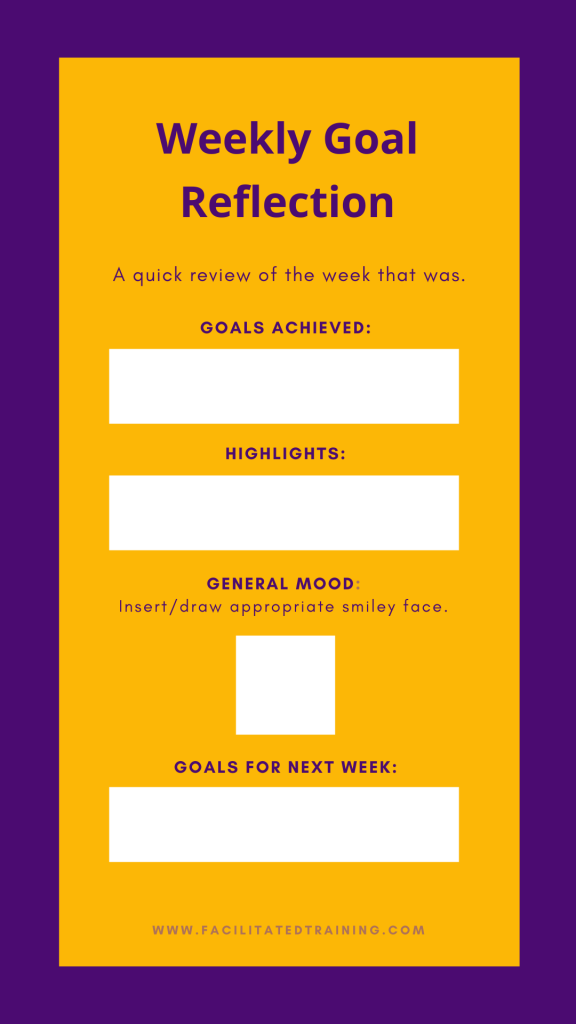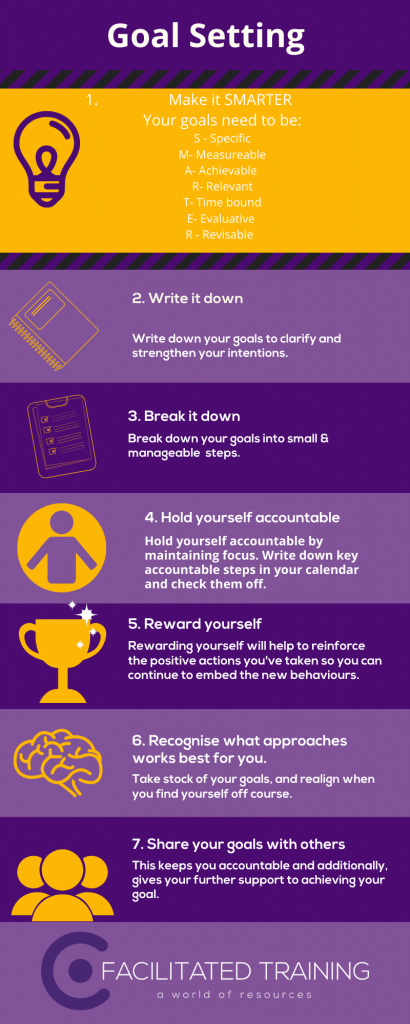How to set and accomplish personal and workplace goals.
It probably feels like groundhog day, because chances are, you have been here before, either setting New Years Eve resolutions, personal goals – (saving for a house, getting fit…) or setting goals and key performance indicators in the workplace.
Wikipedia says that “Goal setting involves the development of an action plan designed to motivate and guide a person or group toward a goal. Goal setting can be guided by goal-setting criteria such as SMART criteria. Goal setting is a major component of personal-development and management literature.”
Pablo Picasso said “Our goals can only be reached through a vehicle of a plan, in which we must fervently believe, and upon which we must vigorously act. There is no other route to success.” And he was right. Setting goals is closely aligned to creating a new habit. So, there are a few things to keep in mind that will help to accomplish your goal.
-
Write goals that align with your values.
There isn’t a huge difference between corporate goals and life goals. If your career goals aren’t supporting your life goals, you are bound to be impacted both in your personal life and work environment. For example, if you want to become a chef, working as an accountant isn’t going to be particularly helpful. However working as an accountant in a workplace that has flexible work practices will make studying part-time to become a chef, more achievable.
“By recording your dreams and goals on paper, you set in motion the process of becoming the person you most want to be. Put your future in good hands—your own.” —Mark Victor Hansen
-
Set goals that you can control.
Too often, we set goals that depend on other people, and this is where many of us stumble. You will be invested in achieving your goals – but others, not so much unless there is a benefit to them also.
When seeking support for your goal, remember to also seek out the benefit to others. For example, in the workplace, your goal may be completing a development course in better utilisation of excel. Sell the interest of you completing the path to your manager by linking it to faster reporting and analysis.
If you are seeking to get fit – then seek out your support person who has a similar goal and utilise your common goal to motivate each other.
Unless every aspect of the goal you set is under your control, you have very little likelihood of ever achieving it.
-
Give yourself time.
Begin with the end in mind, that is to say, if you start by visualising where you want to end up in life, the things you need to get there are pretty easy to plot out. This is similar to project planning. Identify what success looks like.
- When will you know that you have been successful?
- What date will this occur by?
- What does it look and feel like?
- The more detailed the image, of what completion of the successful goal looks like to you, the easier it will be to identify the steps that you will need to take to achieve it.
-
Plan for success.
Don’t worry that your dreams aren’t realistic or that you might not achieve them. Instead, ask not, “What if I fail?” but rather, “What if I succeed?” Worry about failure is pointless and destructive. Your goals won’t just accomplish themselves; you will have to have a plan, and you’ll have to work that plan.
This includes realignment back to your goal- when you find yourself off course. Capture key dates and deliverables for your goals. Diarise them. Put in alerts into your smartphone, to remind you of your actions to complete.
“A goal properly set is halfway reached.” —Zig Ziglar
-
Read, Listen and Learn
Setting goals is not about accomplishing things as much as it is about personal growth.
When you set goals that are challenging, you will have to become more skilled in order to accomplish those goals.
That is why it’s important that you read, listen and learn to achieve your goal. This could include listening to podcasts, watching YouTube videos, attending training, obtaining a mentor. Often achieving your goals, requires engaging with new skills and experts to achieve your goals.
-
Manage your risks.
You will never achieve goals you didn’t set, but then again there are precious few guarantees in this life
And while most of the things you will do on your journey to success will carry some measure of risk, that’s okay. Just be sure that you consider that risk and weigh it against the reward.
Leadership and Goal setting in the workplace.
Professional development is a win-win for you and your managers. As your managers advance in their careers, you benefit from a motivated workforce with an up-to-date skillset. Specific goals, when accomplished, elevate the performance of your entire team, through enhanced communication, productivity and retention.
Before you put new initiatives in place, first become clear on the meaning of a professional development goal. Take concrete steps to make a professional development plan and work with your team to make it happen.
What Is a Professional Development Goal?
Every employee should be encouraged to grow on the job. Professional development goals are an employee or management-led objectives to accomplish during a particular time period. A professional development goal may be job-specific, such as to complete cross-training with another department. A goal might also be more general, such as to participate more in professional organizations or demonstrate certain skills or behaviours back on the job. Goals are typically discussed and set either during employee performance evaluations or on a quarterly basis.
You can use several different techniques to support employees in reaching these goals. Identifying not only the goal, but also actions, gives managers a clear path to achievement. These may include formal training, mentoring from a senior employee or delegation of an important project that challenges the manager’s skills. Professional development plans represent an investment in employees, which they should reciprocate with increased dedication to the organization.
There is an art to establishing objectives for your leaders, so make sure that the professional development goals you set are:
- Clear – Managers should easily understand the goals they’re working toward and why those goals are necessary. These goals should be linked back to organisation strategy and goals
- Measurable– The ability to identify progress encourages employees and boosts confidence. This is even more important if the goal is linked to a bonus or pay rise of the employee
- Realistic– While goals should be challenging, they should also be achievable.
- On A Timeline– When goals have beginning and endpoints, team members work to reach the finish line.
- Rewarded– If a goal is achieved, it’s essential to give recognition. This heightens employee confidence and encourages further progress.
Each company and its goals are different. At the end of the day, make sure you are collaborating with your team to identify overall objectives that make the most sense for your organization. Then, identify the role of each member of your management team should play in achieving those objectives. Before meeting with each employee, brainstorm some items that should be included in a professional development plan, including goals and ways to achieve them. In your conversation with the employee, work with them to develop timelines and markers of achievement to make the initiative a success.
To help you get the process started, Facilitated Training has created customisable training materials and templates.
Check out examples of our training materials here:
Facilitated Training has the solution that you need. Editable training materials that can be used again and again. Insert your company logo, add in case studies or examples from your workplace, or train using the quality training materials, as is.
Facilitated Training is your one-stop-shop for world-class, customisable training and professional development resources.
Facilitated Training offers training and organisational development resources to facilitators, trainers, coaches, HR managers and individuals.
Specialising in customizable leadership and management skills, Facilitated Training features a wide variety of products, including Training resources, Professional development courses, assessments, ebooks, videos and more.
About the author: Colleen Condon
Colleen likes to keep things creative in all that she does, often using marshmallows as a source of inspiration.
Everyone knows that ongoing learning is essential for both personal and professional success and yet, for many, this means hours of attending dead boring training or completing’ losing the will to live’ eLearning modules. Colleen’s mission is to end tedious professional development while ensuring targeted outcomes for learners and businesses.
Colleen has honed her skills over the last 20 years across multiple industries and locations. Her previous role saw her overseeing the training and development needs of over 60, 000 employees across 13 countries in the APAC region. This enabled honing skills that celebrated diversity and understanding human commonality through learning, and that in the absence of a common language, flip charts and coloured markers can overcome most challenging situations.
After taking a ‘go away package’, in 2019, Colleen founded her own business, Facilitated Training, harnessing her global learning experiences and sharing them through ready to use learning resources, specialising in leadership, mentoring, guest speaking, creative problem solving, filling the gap of high quality, customisable training resources and tools.


